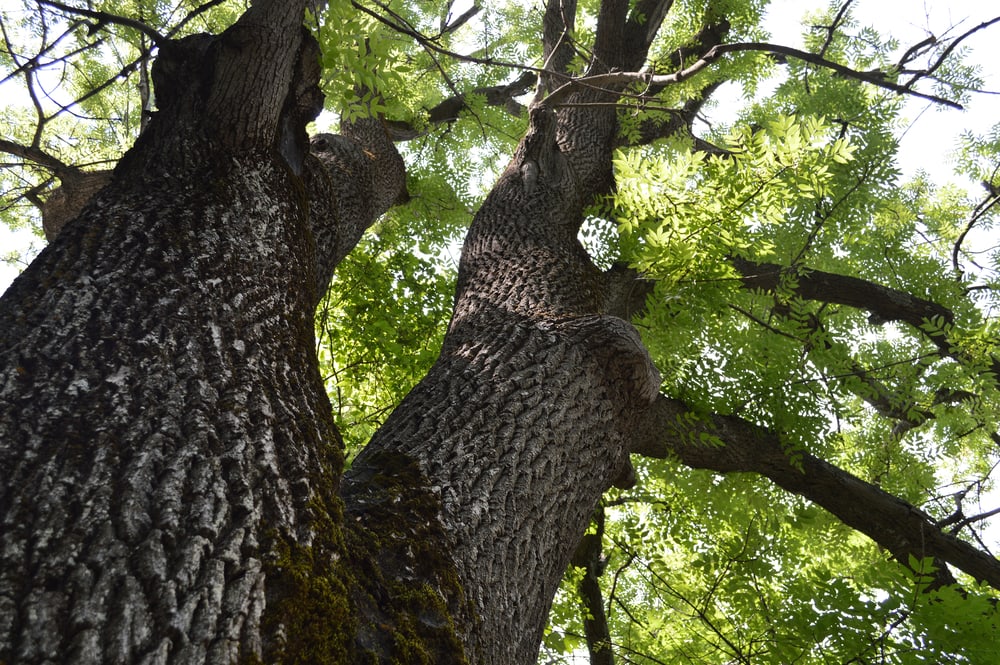12 Types of Trees in Tennessee (with Pictures)
-
Kristin Hitchcock
- Last updated:

Tennessee is home to many types of trees. The state is basically one giant forest except for the few developed areas that exist. Therefore, you’ll easily come across trees of all sorts across the state.
Of course, the climate and environment do change a bit depending on where you are in Tennessee. Therefore, the exact types of trees differ, too. For instance, you can find oak trees across the state, but the exact subspecies will depend on where you are.
Below, we’ll take a look at some of the most common trees in the state, as well as tips on identifying them.
The 12 Common Types of Trees in Tennessee
1. American Beech

The American Beech has extremely smooth bark, as it grows very slowly. This tree is particular about where it grows, so spotting it tells you a lot about the surrounding areas. It prefers moisture areas that drain well. Therefore, it typically grows on north-facing slopes.
In the summer, this tree’s leaves are extremely dense and there is typically very little undergrowth beneath the tree. Usually, the trees stick around through most of the winter, though they turn light tan after the first frost.
Its leaves are extremely oblong and about 3- to 5-inches long.
2. Ash

There are two common species of ash across Tennessee: green ash and white ash. Often, green ashes are found in wet areas, while white ash prefers well-drained soil. Both look rather similar with light tan to grey bark that grows rough. Usually, the surface of the bark is crumbly and will come off easily when rubbed. The branches usually have blunt tips and are not particularly pointy.
These trees have compound leaves that grow opposite each other. Leaf bunches range from three to seven.
3. Black Walnut

Black walnut trees are rather easy to identify. Their bark is dark and rough. Often, you’ll only find a few sturdy limbs. The tree typically grows under the assumption that quality is better than quantity. The odor of this tree is also distinctive. However, you’ll need to cut away at the bark to get a good whiff of it.
The leaves are very small at only 1- to 2-inches.
4. Eastern Redcedar

Red cedar has a very interesting bark compared to other native trees. The bark is light in color and peels away in strips. It is often smooth. However, worn bark will have many strips hanging off of it. This conifer’s leaves are scale-like. Usually, they are densely packed, which prevents plants from growing underneath them. The leaves are only ¼ inches long. However, they grow all over the twigs, making it difficult to see the wood underneath.
Of course, because this tree is cedar, it smells very distinctive.
5. Flowering Dogwood

This relatively small tree only reaches about 20 feet max. It usually has a rather flat crown and usually doesn’t grow straight, either. The trunk tends to be rather crooked. The bark is dark brown and often broken into scaly pieces. During the winter, the tree begins to produce flower buds.
When spring comes, the tree produces white flowers with four petals. After being pollinated, these flowers will turn into clusters of red berries in the fall.
6. Hackberry & Sugarberry

The hackberry and sugarberry are two relatively common trees that can be found throughout Tennessee. These trees are rather large and like to grow on top of limestone deposits, which are common throughout the state. You’ll often find these trees growing along fences.
These trees look very similar to beech. However, there are key differences to help you figure out which is which. Most easily recognized, these types of trees often have a bumpy bark, while the beech is completely smooth. Furthermore, these trees also produce tangles of twisted twigs at the end of their branches, which help them stand out from other trees.
7. Hemlocks

You’ll find hemlocks most commonly in the eastern part of the state. As you’d guess, these conifers have leaves throughout the year. Often, the lower limbs tilt downwards before flaring up at the tips. Almost always, this tree grows in moist, well-drained areas. It likes the northern-facing slops the most.
While there are two different hemlock trees, these are fairly similar and grow in similar areas. Therefore, it often isn’t necessary to tell them apart.
This tree has long needles that are flat. The ends are blunt, so they often aren’t as pokey as other conifers. Branches tend to hang in layers and remain parallel to the ground.
8. Locust

There are several types of locust trees in Tennessee. These trees have light brown bark that is often flat. However, large scales will develop on older trees. You can identify these trees rather easily thanks to the thorns along their twigs and trunks. Often, these thorns are as large as 4 inches.
Their leaves are extremely small and grow in groups. Often, these groups are 8- to 14-inches long with 12 to 20 leaves. Some species even have double-compound leaves, which means that there are groups growing within groups.
9. Sycamore

The sycamore tree is pretty easy for even novices to identify thanks to its peeling bark. Often, the light brown bark on the outside of the tree peels away to reveal extremely white inner bark. Therefore, the trees are often described as looking like bones with peeling pieces of skin.
The trunk and larger limbs will both shed their paper-thin outer bark. Some individual trees will have more outer bark than others, depending on the environment it is growing in.
The leaves are quite large at up to 8-inches wide. Usually, they have a fan shape, though the leaves are quite irregular. Sycamore leaves are usually larger than a man’s hand, making them pretty easy to identify.
10. Sugarbark Hickory

Often, you’ll find hickory trees on dry, well-drained sights. Therefore, they prefer the south-facing slope, where it is typically dryer. This tree also has peeling bark like the sycamore. However, the inner bark and outer bark have the same color. Furthermore, the outer bark is rather thick and looks like bark—not paper.
Despite the fact that this tree’s bark does peel, the bark itself is rather strong. Therefore, the peeled bark remains on the tree for some time before falling off.
11. White Pine

White pine is one of the easiest trees to identify because of its branching pattern. The branches come off of the trunk in a wheel-like manner. These trees are extremely orderly, unlike most other species. The tree will grow a new ring of branches every year, allowing you to identify the tree’s age by counting the rings.
The bark is a light grey color. The needles are blue-green and extremely soft. They are flexible and grow in small bundles.
12. Winged Elm

Compared to other trees, the winged elm is a bit more difficult to identify. However, you can usually ID it based on the ridges that grow along two sides of the branches and twigs. These ridges break off easily and actually make good kindling. Often, the tree itself is small and prefers rocky areas.
The leaves are rounded and slightly larger on one side. Therefore, they aren’t perfectly symmetrical like most leaves.
Conclusion
There are tons of tree species in Tennessee. Luckily, many of them can be identified easily if you know only a few characteristics. Practically every kind of tree has something unique about it, which allows you to tell it apart from others easily.
Of course, each tree is an individual. Therefore, different trees will have slightly different characteristics. You have to look at the whole tree to identify it. Don’t just rely on a single characteristic.
- See also: Can a Pear Tree Pollinate An Apple Tree?
Featured Image Credit: paulbr75, Pixabay
Contents
